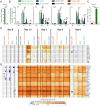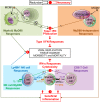Natural Killer Cell Sensing of Infected Cells Compensates for MyD88 Deficiency but Not IFN-I Activity in Resistance to Mouse Cytomegalovirus
- PMID: 25954804
- PMCID: PMC4425567
- DOI: 10.1371/journal.ppat.1004897
Natural Killer Cell Sensing of Infected Cells Compensates for MyD88 Deficiency but Not IFN-I Activity in Resistance to Mouse Cytomegalovirus
Abstract
In mice, plasmacytoid dendritic cells (pDC) and natural killer (NK) cells both contribute to resistance to systemic infections with herpes viruses including mouse Cytomegalovirus (MCMV). pDCs are the major source of type I IFN (IFN-I) during MCMV infection. This response requires pDC-intrinsic MyD88-dependent signaling by Toll-Like Receptors 7 and 9. Provided that they express appropriate recognition receptors such as Ly49H, NK cells can directly sense and kill MCMV-infected cells. The loss of any one of these responses increases susceptibility to infection. However, the relative importance of these antiviral immune responses and how they are related remain unclear. In humans, while IFN-I responses are essential, MyD88 is dispensable for antiviral immunity. Hence, a higher redundancy has been proposed in the mechanisms promoting protective immune responses against systemic infections by herpes viruses during natural infections in humans. It has been assumed, but not proven, that mice fail to mount protective MyD88-independent IFN-I responses. In humans, the mechanism that compensates MyD88 deficiency has not been elucidated. To address these issues, we compared resistance to MCMV infection and immune responses between mouse strains deficient for MyD88, the IFN-I receptor and/or Ly49H. We show that selective depletion of pDC or genetic deficiencies for MyD88 or TLR9 drastically decreased production of IFN-I, but not the protective antiviral responses. Moreover, MyD88, but not IFN-I receptor, deficiency could largely be compensated by Ly49H-mediated antiviral NK cell responses. Thus, contrary to the current dogma but consistent with the situation in humans, we conclude that, in mice, in our experimental settings, MyD88 is redundant for IFN-I responses and overall defense against a systemic herpes virus infection. Moreover, we identified direct NK cell sensing of infected cells as one mechanism able to compensate for MyD88 deficiency in mice. Similar mechanisms likely contribute to protect MyD88- or IRAK4-deficient patients from viral infections.
Conflict of interest statement
The authors have declared that no competing interests exist.
Figures





Similar articles
-
MyD88-dependent and -independent murine cytomegalovirus sensing for IFN-alpha release and initiation of immune responses in vivo.J Immunol. 2005 Nov 15;175(10):6723-32. doi: 10.4049/jimmunol.175.10.6723. J Immunol. 2005. PMID: 16272328
-
IFN-alphabeta-mediated inflammatory responses and antiviral defense in liver is TLR9-independent but MyD88-dependent during murine cytomegalovirus infection.J Immunol. 2007 Nov 1;179(9):6176-83. doi: 10.4049/jimmunol.179.9.6176. J Immunol. 2007. PMID: 17947693
-
Natural killer cells promote early CD8 T cell responses against cytomegalovirus.PLoS Pathog. 2007 Aug 24;3(8):e123. doi: 10.1371/journal.ppat.0030123. PLoS Pathog. 2007. PMID: 17722980 Free PMC article.
-
MCMV avoidance of recognition and control by NK cells.Semin Immunopathol. 2014 Nov;36(6):641-50. doi: 10.1007/s00281-014-0441-9. Epub 2014 Aug 21. Semin Immunopathol. 2014. PMID: 25141793 Review.
-
Immunoregulatory cytokine networks: 60 years of learning from murine cytomegalovirus.Med Microbiol Immunol. 2015 Jun;204(3):345-54. doi: 10.1007/s00430-015-0412-3. Epub 2015 Apr 8. Med Microbiol Immunol. 2015. PMID: 25850988 Free PMC article. Review.
Cited by
-
Invariant natural killer T cells: front line fighters in the war against pathogenic microbes.Immunogenetics. 2016 Aug;68(8):639-48. doi: 10.1007/s00251-016-0933-y. Epub 2016 Jul 1. Immunogenetics. 2016. PMID: 27368411 Free PMC article. Review.
-
Siglec-H protects from virus-triggered severe systemic autoimmunity.J Exp Med. 2016 Jul 25;213(8):1627-44. doi: 10.1084/jem.20160189. Epub 2016 Jul 4. J Exp Med. 2016. PMID: 27377589 Free PMC article.
-
MyD88-dependent inflammasome activation and autophagy inhibition contributes to Ehrlichia-induced liver injury and toxic shock.PLoS Pathog. 2017 Oct 19;13(10):e1006644. doi: 10.1371/journal.ppat.1006644. eCollection 2017 Oct. PLoS Pathog. 2017. PMID: 29049365 Free PMC article.
-
Induction of IL-12p40 and type 1 immunity by Toxoplasma gondii in the absence of the TLR-MyD88 signaling cascade.PLoS Pathog. 2021 Oct 1;17(10):e1009970. doi: 10.1371/journal.ppat.1009970. eCollection 2021 Oct. PLoS Pathog. 2021. PMID: 34597344 Free PMC article.
-
Genomic Modifiers of Natural Killer Cells, Immune Responsiveness and Lymphoid Tissue Remodeling Together Increase Host Resistance to Viral Infection.PLoS Pathog. 2016 Feb 4;12(2):e1005419. doi: 10.1371/journal.ppat.1005419. eCollection 2016 Feb. PLoS Pathog. 2016. PMID: 26845690 Free PMC article.
References
-
- Zhang SY, Boisson-Dupuis S, Chapgier A, Yang K, Bustamante J, Puel A, et al. Inborn errors of interferon (IFN)-mediated immunity in humans: insights into the respective roles of IFN-alpha/beta, IFN-gamma, and IFN-lambda in host defense. Immunol Rev. 2008;226:29–40. 10.1111/j.1600-065X.2008.00698.x - DOI - PubMed
Publication types
MeSH terms
Substances
Supplementary concepts
Associated data
- Actions
LinkOut - more resources
Full Text Sources
Other Literature Sources
Molecular Biology Databases

